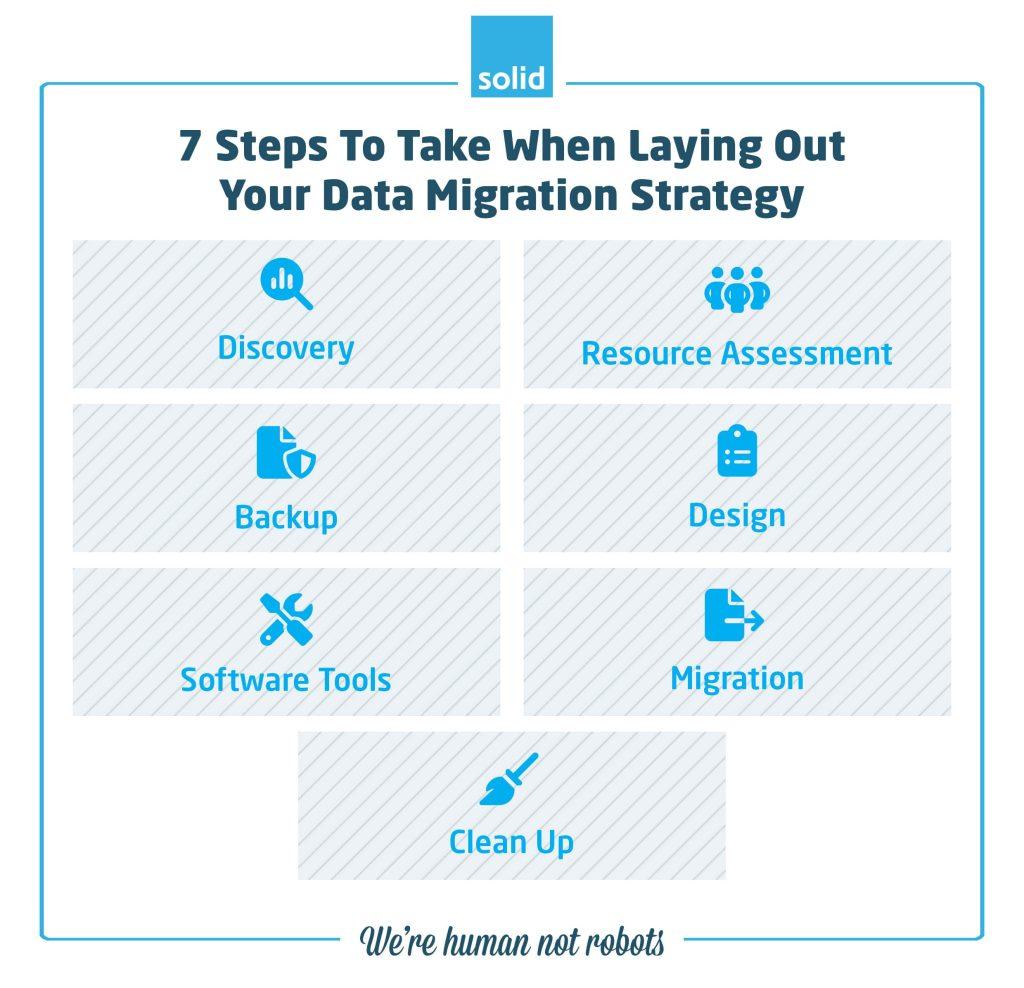
Change never happens all at once. At least, not when it comes to changing approaches within business. It takes time, planning, strategising, and even when you have reached the point where you’re ready to effect change, there is the implementation itself that can be complex and time consuming.
The perfect example of this is data migration.
What Is Data Migration?
Data migration involves moving information from one platform to another, and it could be broken down into a number of different categories.
There is storage migration, which involves switching hard drives or servers, which can also take place during a data centre migration.
There is cloud data migration, which involves moving data from on premises solutions into cloud services, or from one cloud solution to another. SharePoint data migration is the perfect example of this.
App migration occurs when your business adopts new technologies and needs to transfer data from an old software solution into a new one – when changing your accounting tool, for example.
A database migration will often occur when updating databases from a legacy system to a new one, when changing the structure of existing databases, or when you need to migrate data from one database to another.
And then there are business process migrations, which happened alongside big changes to your company like acquisitions, mergers, or new target markets.
Why Is A Data Migration Strategy Important?
Whenever you are changing the way that information is stored, accessed, or processed, it’s important to have a strategy in mind for doing so. This will help you to minimise risk, and ensure that your data migration activities cause as little impact on your operations as possible. Any unexpected downtime can have serious implications for your finances and your reputation, while extended outages can also see you losing market share. All of this needs to be taken into careful consideration, which is why putting a data integration strategy in place is going to be critical to the project’s success.
What Are Some Of The Challenges To Data Migration?
When it comes to data migration in cloud computing and other scenarios, there are a few common problems that businesses experience during the migration process. Addressing these within your strategy will allow for a smoother transition overall, and can prevent a good deal of frustration along the way.
• Data Gravity
Data gravity is all about the sheer volume of information that businesses store and generate, and the way that it multiplies and becomes ingrained in your processes over time. One app may need your data to be in one format, while another may need an entirely different structure. Data can sync between certain apps making it significantly more difficult to switch platforms since it will break this integration. All of this needs to be considered when planning out a data migration.
• Data Integrity
When switching to a new platform, you’ll want to simplify the process as much as possible by ensuring that the latest and most up-to-date data is transferred, while redundant data is ignored. But this requires that your existing data integrity is sound – that files aren’t being replicated unnecessarily, and that no data becomes lost or compromised during the migration.
• Compliance
Regulations like South Africa’s Protection Of Personal Information Act and the EU’s General Data Protection Regulation have strict guidelines in place for how data can be stored, accessed, managed, and processed. You’ll want to bear these regulations in mind when planning your data migration, since non-compliance can result in harsh penalties – for your finances and your reputation.
• Time And Cost
Time and cost are two critical factors to consider as part of your data migration strategy, and they are closely linked. You can opt for an approach which prioritises a quick transition, reducing operational overheads but potentially resulting in data becoming compromised or inaccessible if errors arise. Or you could opt for a slower transition, necessitating that two systems run simultaneously, costing more initially but ensuring fewer hiccups and a smoother migration overall.
• Inexperience
The vast majority of businesses are not well equipped to handle data migration on their own. They need a reliable partner to guide them during the transition. This is where working with data migration companies and Managed IT Services providers like Solid Systems, can mean the difference between a successful data migration and a project going awry.
Top Strategies In Data Migration
When planning out data migration strategies, there are two contrasting approaches that most businesses take. Each comes with its own advantages and risks, and deciding which strategy is best for your business will largely depend on the volume and complexity of the information that needs to be migrated, and its role in supporting your business operations.
• Big Bang Migration
Much like the theory behind the creation of the universe, the Big Bang approach to data migration sees everything taking place at once. The transition is quick – an old system is turned off, and a new one is turned on. Because it happens at the same time, you go from paying for one platform, to paying for another with minimal overlap, making this the less costly approach. But this also means that there’s little opportunity for testing, increasing the risk of errors occurring or data becoming compromised or inaccessible.
• Trickle Migration
A Trickle data migration strategy involves slowly moving data from one platform to another, and slowly switching platforms once testing has confirmed that they are operating as expected. This is a more conservative approach, and a more costly one, since the two platforms will need to run simultaneously for an extended period of time to ensure successful migration. But this is also the data migration strategy that carries the least risk when it comes to business continuity.
Steps To Take When Laying Out Your Data Migration Strategy

Now that you have an understanding of why planning out your data migration is essential to the transition success, let’s take a look at the steps that your migration and data protection strategies should include.
• Discovery
Because you’re planning to boldly move when none of your data has gone before, it’s important that you have a full understanding of the data you’re going to migrate, how it’s already stored and accessed, and how the new platform needs it to be structured for an effective transition. This is also a great opportunity for you to understand how much data needs to be migrated, and how much storage space you will require on your new platform.
• Resource Assessment
You want to make sure that all stakeholders are on the same page, and that the person (or IT team) responsible for the migration understands their role and requirements. Having a plan in place for who your humans should turn to if they notice a problem will also make for a far smoother process.
• Backup
With any data migration, there is the potential for information to get lost or for processes to go wrong. This is why you need to ensure that you have reliable and recent backups of all data that needs to be transferred, and a recovery plan in place to ensure that it’s brought back online with minimal disruption to operations if a problem does arise.
• Design
Which data migration approach are you going to choose – Big Bang or Trickle?
What time frame does the migration need to be completed within?
What changes need to be made to your data structure to accommodate the new platform?
These questions will all be answered during the design phase of your data migration strategy, where you plot out a win and how the transition will occur.
• Software Tools
There are plenty of data migration solutions out there to help with your efforts, data migration automation tools or Microsoft Azure Migration tools, and finding the right one for your needs will depend on the type of migration that you are undergoing, your time frame, your familiarity with the process, and more.
This is one of the areas where having a team of IT pros ready to support your business and offering advice and IT consulting can be instrumental to making your migration a success, since they’ll be able to recommend the perfect solution for your needs.
• Migration
This is when all of your planning comes to a head. The migration begins, and it’s time to make sure that the process runs smoothly by testing throughout.
• Clean Up
Once the data has been migrated successfully onto the new platform, you’ll want to make sure nothing is missing and everything is running as expected. This is the perfect time for an IT audit to check your data’s integrity and accuracy, ensuring that you’re set up for success on your new environment.
How Can Solid Systems Help?
As you can tell, most data migrations are complex processes that need to be carefully planned and implemented in the right way. Having an IT company by your side with over two decades of experience in helping businesses embrace cloud platforms, make use of Microsoft’s Azure data migration service, transition their data across storage devices, migrate data to SharePoint or adopt new applications to improve their operations can be your biggest asset during a data migration process.
Whether you are ready to transition to a new platform, want to migrate your data and are looking for a data migration assistant, or are looking for the best IT advice or cloud consulting, get in touch with Solid Systems today, and see the difference that their strategic technology planning can make for your business.
Frequently Asked Questions (FAQs)
There are seven steps that businesses follow when implementing data migration strategies. These ensure that your data is well protected and secured during the process, and that thorough testing is done within your new environment to reduce the risk of downtime or disrupted operations. The phases are:
- Discovery
- Resource assessment
- Backup
- Design
- Software tools
- Migration
- Clean up
There are plenty of software tools out there including Azure Migration solutions which can help your business to smoothly transition data from one platform to another. But finding the right one for your needs will depend on the type of migration that you are undergoing, your time frame, your familiarity with the process, and more.
This is one of the areas where having a team of IT pros ready to support your business and offering advice and IT consulting can be instrumental to making your migration a success, since they’ll be able to recommend the perfect solution for your needs.
Data migration is often not an easy process, and requires a good deal of effort and planning to ensure success. Some of the common challenges that businesses come across when migrating their data include:
- Data gravity
- Data integrity
- Compliance
- Time and Cost
- Inexperience
While the process of migrating data from one platform to another can be a time consuming and costly process, it is a decision that many businesses make for a variety of different reasons, including the flexibility that it affords them in the long run when migrating to the cloud, being able to adopt new technologies that can help to move a business forward and see them achieving their goals, and a fixed monthly fee which is always predictable, as opposed to solutions which may cost less to operate initially, but need regular upgrading or replacement.
Popular Searches
- Types Of Network Security
- What Is Social Engineering?
- What Is Cyber Hygiene?
- Examples Of Cyber Attacks
- Online Shopping Security Threats
- What Is Identity Theft?
- POPI Act Compliance Checklist
- Preventing Cyber Attacks
- What is Cloud Infrastructure?
- Brief History Of Microsoft
- Cloud Computing For Small Businesses





